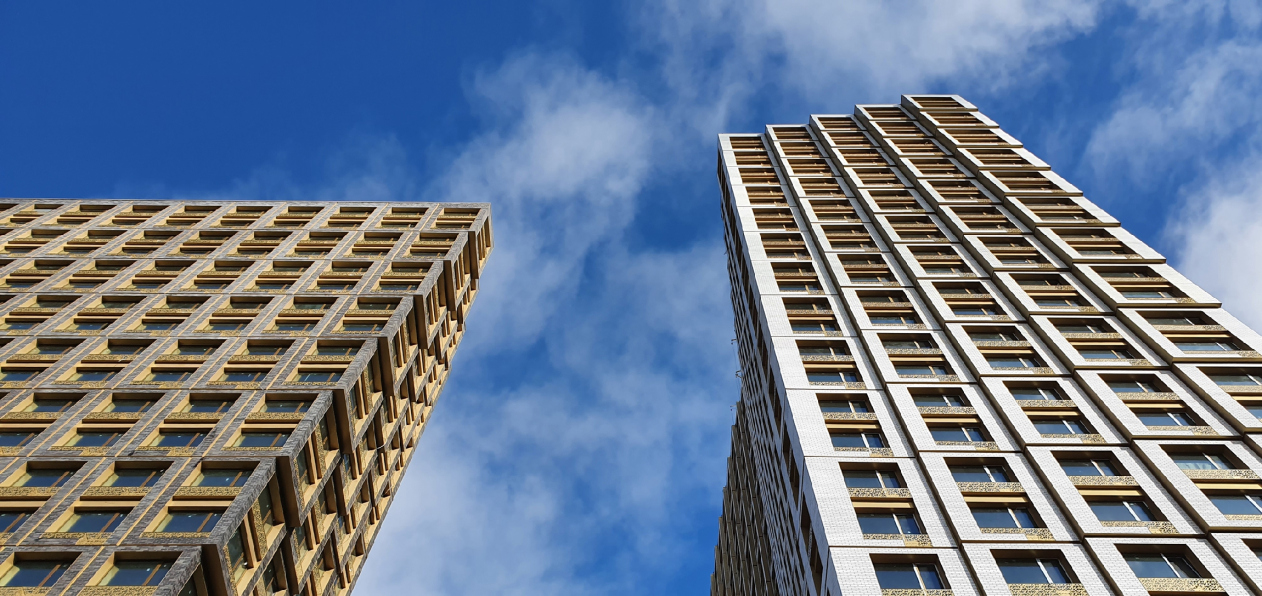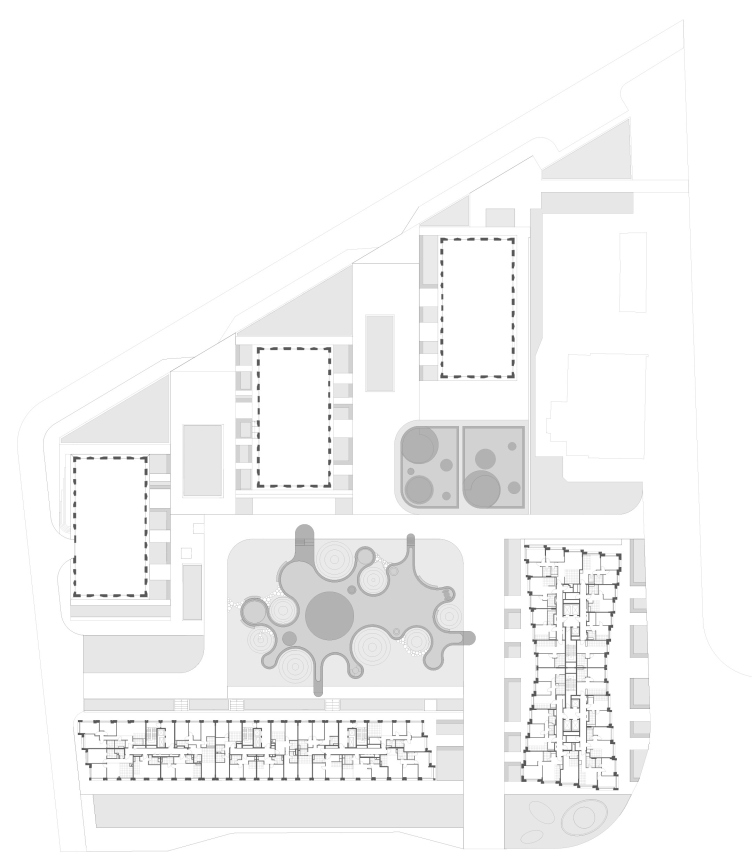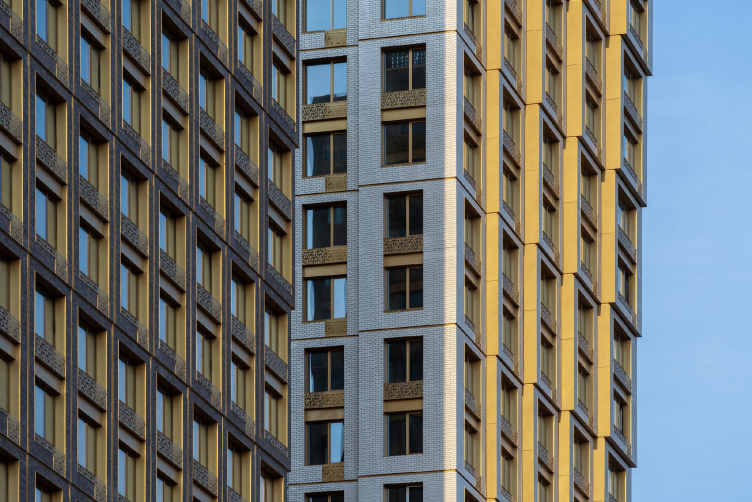As for the overall composition, we did it together because we had to mutually agree on the layouts and insolation. Further on, however, when the overall composition was settled, the plastique of the facades was individually designed by each team, and we saw the final version developed by our partners in the very end. Our colleagues came up with more laconic buildings, we – with ones that were richer in plastique.
The master plan. Discovery housing complex
Copyright: © ADM
Thus, the task that was posed before ADM consisted, among other things, in accentuating the “façade” contour of the complex overlooking the city and consisting of two houses: the corner one (light) 31 stories high, and the other one (dark) – 23 stories high.
ADM architects proposed a dynamic technique: the volumes seem to be composed of two-tier cells, which become “mobile” at accent points, i.e. at the corners. It seems as though the architects took the cells, securely linked to one another by the force of inner stability, and slightly “tugged them at the corners”, giving extra plastique to the contour. The structure of these “agile” or “mobile” or “flexible”” cells looks like either a spread-out fan, or the stretched bellows of the accordion or a pleated fabric stretched over the frame.
Discovery housing complex
Copyright: Photograph © Alesya Malomuzh / provided by ADM architects
The side ends of both volumes became prominently diagonal, while the “light” corner house – which in this case occupies the main position – got a “waist” ledge on its elongated sides, so its floor plan began to look like an hourglass, and its volume – viewed both from the yard and from the road junction (which is more important from the town-planning standpoint) – began to look like an open book.
The “open book” house, which only remotely resembles the famous “open book” COMECON tower on New Arbat, is the main façade of the complex that draws everybody’s attention. The developer’s representatives share that the form luckily coincided with the develop-given name of “Discovery” – according to the brand book, the resident complex is positioned as a home for people who are “open to the world”, which is echoed by the open book shape and the large panoramic windows.
The “slab” house is completely subjugated to a diagonal motion – as if it “strides” along the drive – and its dark tone serves as a transition to the brown color of the towers designed by the colleagues in the yard – in combination with them, the building forms a “backdrop” that highlights the light color of the corner building, visually moving it to the foreground as the leader of the entire composition.
The two houses, virtually perpendicular to one another, similar in structure and patterns, but different in height and silhouette, form a couple, echoing each other contrastively, like light and dark, vertical and horizontal, or, maybe, even yin and yang.
The cells, which form the shape, are reminiscent of the structuralism stylistic device of the 1970’s, the only difference being that they change not so much their pattern as – gradually – their size. This ingenious kinetic fan-like shape is connected with the configuration of the apartments, albeit not directly. “Every developer wants their apartments to gradually grow from small to large with a small pitch. And they also want bigger apartments at the top, and smaller ones at the bottom. So, what it ends up being is that you design a single-room apartment, then with each next floor it grows a little bit bigger, and then it turns into a small two-room apartment. Then the two-room apartment, gradually growing, turns into a small three-room apartment after a few floors. In Discovery, this increase in size goes not just vertically, but also from center to periphery, with the windows growing wider. Of course, this is not a direct reflection of the apartment layout – we had to tweak a few things and bend a few rules to achieve that. Of course, we could have done this in the straight building but we preferred a more interesting option” – Andrey Romanov says.
The two-story cells are articulated with brick frames (faced with ceramic tiles, visually indistinguishable from bricks). The cells look like construction blocks, already put by the crane in place, yet not assembled completely – as if they live this “modular idea” in front of our eyes, forming the image of the modular house – while in actuality the structures are, of course, monolithic. The modular cells create the form and give it a feel of movement. The human eye perceives them as being identical, which further works to create this “stretching” effect, a truly plastique paradox.
Discovery housing complex
Copyright: Photograph © Yaroslav Lukyanchenko / provided by ADM architects
Semantic allusions to the idea of a “prefabricated block house”, which may arise when studying the shape of both houses, are more than offset by the “precious” golden decoration – this anything but a cheap prefab project. Rather, these are the drawers of some precious antique piece of furniture. This theme is first of all supported by the ornamented frames of the windows, combined with the cases of the air conditioning units – made of spray-painted steel, golden window frames, and the color of inserts between the floors – all of this creates the effect of a precious “lining”, shading the main brick surface. The lattice pattern resembles some kind of dense, barely readable italics, as if the building were partly a letter written in gold ink.
Discovery housing complex
Copyright: Photograph © Yaroslav Lukyanchenko / provided by ADM architects
Discovery housing complex
Copyright: Photograph © Yaroslav Lukyanchenko / provided by ADM architects
All the golden elements, the lattices, and the “lining” come together to form “threads” that to an equal degree run through both facades, demonstrating their kinship with each other and emphasizing the relief; endowing the form with glitter and glow. The golden color works not just the sign of value and expensiveness, but also in a broader sense – as a color that unites everything, a visual analogue of a “force field”, which seems to hold this entire deconstructivism form on the edge of slight teetering of the matter.
The yard, delineated from two sides by a white and a black residential slabs, and from a third side by the three towers designed by the partner company, is landscaped by the ADM architects project. It is covered with grassy hills with trees growing from them, whose red and yellow foliage will become in fall a perfect match to the golden patterns of the facades. The coverage of the playgrounds has smooth forms, as if flowing in between the hills. Forms just as flowing are given to the climbing construction, compound and multilevel, yet at the same time a single whole and following the playground blueprint.
Back to the architecture, though: ADM architects are particularly expert at designing the plastique of the wall. Starting from the house on Berzarina Street, where the noble, old-brickwork-imitating, surface of brick tiles and French windows were complemented by curious wooden “shutters”, and ending with the dramatic composition of the housing complex “Malaya Ordynka 19”, where the architects created not just one, but three kinds of textured surface: Klinker pleated texture with intricate lattices, stone with wooden inserts, and glass waves. The architects have considerable experience in this area. Solutions just as interesting were used in the façade tectonics of the Vitality housing complex.
The composition of the Discovery housing complex is reminiscent of Vitality, because it is also based on the counterpoint of two buildings, long and vertical, dark and light, and is endowed with accented plastique that reveals the depth and relief of the façade. Discovery, however – in full accordance with its name – goes a little bit further: it bends and molds its surfaces, embellishing and adding visual kinetics with discrete stylistic techniques,, balancing on the verge of a simple, restrained, yet appropriate and agile form. Which, doubtlessly, in combination with the “golden lining” adds to visual value the facades of the main high-profile buildings – just in accordance with the well-known maxim that an architectural solution can significantly increase the value of a project.
























































